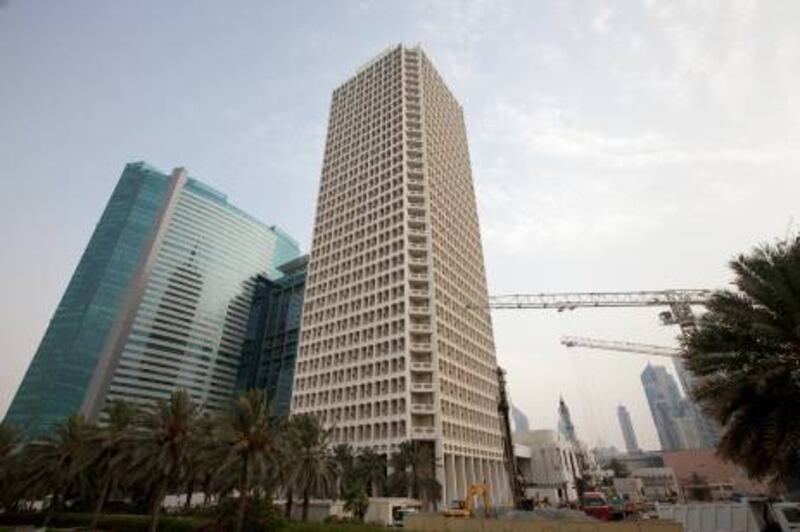DUBAI // The Dh100 note is in a league of its own, capturing the story of Dubai through two of its most historically significant buildings.
The pink note has on its front the oldest building in Dubai - the Al Fahidi Fort - and, on the back, the UAE's first tower, the Dubai World Trade Centre (DWTC).
As the landscape around these buildings changed dramatically, they stood firm to their origins.
Opened in February of 1979 by Sheikh Rashid, the late Ruler of Dubai, and Britain's Queen Elizabeth II, the 39-storey DWTC office tower, at 149 metres tall, was the single tallest building in the middle of the desert at that time.
Although it is now surrounded by far taller and much more distinct skyscrapers, it remains one of the most recognised landmarks along Sheikh Zayed Road.
The fort, built in 1799, was one of the residences of the ruling family of Dubai. It was renovated in 1970 for use as a museum.
It was the ruler's residence until about 1890, when the late Sheikh Maktoum bin Hasher Al Maktoum moved to the Shindagah area of Dubai.
Since its renovation, the fort has housed the Dubai Museum, and is regularly visited by tourists and students.
For the Emirati architect Rashad Bukhash, the Dh100 note carries a particular sentimental value because of the image of the fort on it.
"Our family home was right next to it," said Mr Bukhash, 50, who until the late 1980s was just a few walking steps from the structure.
He remembers when the children's football would fly over the walls of the fort, and the neighbourhood children would compete over who could retrieve it the fastest.
"The fort was everything, a palace and a royal home, a defence structure and garrison, an administrative building with a prison, and a majilis where the people could go and meet their sheikhs," he said.
Mr Bukhash's family moved to Jumeirah with the construction boom in Dubai that began in late 1980s.
However, his relationship with the fort continued: he was one of the main figures behind its renovations. Over the past two decades, he has renovated more than 150 historic sites and buildings in Dubai.
Square-shaped with towers at three of its corners, the fort includes a large courtyard surrounded on three sides by long, narrow halls. Further restoration and galleries were added in 1995. The galleries depict pre-oil Dubai life, with rooms of the former majilis and living quarters transformed into distinct decades of the emirate.
Firing cannons and archaeological discoveries are housed inside, along with galleries that recreate scenes from the Dubai Creek, pearl diving, traditional Emirati houses, souqs, desert and marine life.
"The fort is part of my childhood and part of my adulthood, and is an important historic building for Dubai and UAE as a whole," said Mr Bukhash, who is the director of the Architectural Heritage Department at Dubai Municipality.
Having supervised every inch of the fort's renovations, Mr Bukhash points out that the 12-metre high southern west cylindrical tower should be known as "the leaning tower of Dubai".
"As visitors go inside the fort and follow the path to the underground galleries of various historic periods of Dubai, they should look up and see the leaning tower," he said, leaving it to the visitors to go and find out just how much it is leaning.
The DWTC was designed by John Harris, a famous British architect who also worked on Dubai's first master plan in the late 1950s when there were barely any roads in the emirate. He died in 2008 aged 88.
The trade centre on the Dh100 note is accompanied by a falcon drawn in the bottom left corner. Looking in the direction of the centre, the falcon is symbolic of the national identity as it looks forward to the vision established by the former ruler of Dubai, who went on to transform a section of desert in Dubai into a thriving trade complex.
"It is so beautiful," said Kim Otaki, a Japanese tourist who took photos of the centre from inside a moving Dubai Metro train that passed by the tower on an elevated ramp.
"It has a 1970s feel to it, and stands out from the rest of the glossier towers of Dubai," she said.
The tower once stood alone, high above the desert floor. Over the years, a complex of hotels, exhibition halls and serviced apartment blocks were added around it.
"There is a famous story that goes that the Late Sheikh Rashid would always go to the construction site of the tower, and each time they build a floor, he would go on top of it, and look over his emirate from there," Mr Bukhash said. "He had a vision, and would see what we couldn't."
Last week, we looked at the oryx and the Al Jahili Fort on the Dh50 note. Next week, we will examine the Sharia Court Building, Zayed Sport City and the UAE Central Bank building on the Dh200.






